### Programmable Corpora: Towards a Combined Words/Networks <br />Analysis of Literary Texts <br /><br /> <!-- .element: style="font-size:0.7em;" -->[Frank Fischer](https://www.hse.ru/en/org/persons/182492735) ¹ ² · Eugenia Ustinova ¹ <!-- .element: style="font-size:0.5em;" -->¹ Higher School of Economics, Moscow<br /> ² DARIAH-EU <br /><br /><br /> <!-- .element: style="font-size:0.5em;" -->This presentation: <!-- .element: style="font-size:0.9em;" -->**bit.ly/2WPybvF** <br /><br /><br /> <!-- .element: style="font-size:0.6em;" -->[SUNBELT 2019](https://www.fourwav.es/view/717/info/) · Montréal 🇨🇦 · 20 June 2019 -- ### TOC <br /> 1. Network Research on Drama 2. Programmable Corpora: Networks for Literary Studies 3. Catching Protagonists: Quantitative Dominance Relations --- ## Chapter 1. <br /> ## Network Research on Drama -- ## Literary Network Data as Example Files (1993) <iframe width="900" height="450" src="https://people.sc.fsu.edu/~jburkardt/datasets/sgb/sgb.html" frameborder="0" allow="autoplay; encrypted-media" allowfullscreen></iframe> <small>Donald Knuth: The Stanford Graph Base: A Platform for Combinatorial Computing. ACM Press, 1993. <br />Networks extracted from fiction („Anna Karenina“, „Les Misérables“, etc.) are based on co-occurrences.</small> -- ### One of the First Literary Network Analyses (1998) <br /> 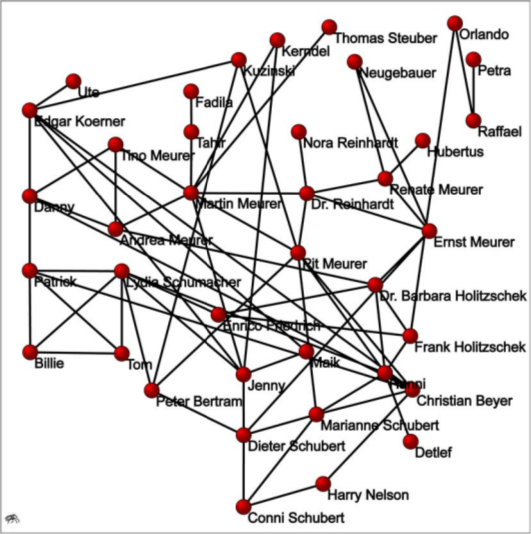<!-- .element width="400px;" --> <small>Thomas Schweizer, Michael Schnegg: *Die soziale Struktur der „Simple Storys“. Eine Netzwerkanalyse.* 1998. ([PDF](https://www.ethnologie.uni-hamburg.de/pdfs-de/michael-schnegg/simple-stories-publikation-michael-schnegg.pdf)) <br />Network extracted from [Ingo Schulze’s](https://en.wikipedia.org/wiki/Ingo_Schulze) novel „Simple Storys“, done by ethnologists. 38 nodes (characters). <br />Edges: positive, negative or exchange relationships. Visualisation with [Pajek](http://vlado.fmf.uni-lj.si/pub/networks/pajek/).</small> -- ### „Les Misérables“ as Example File in Gephi (2008) 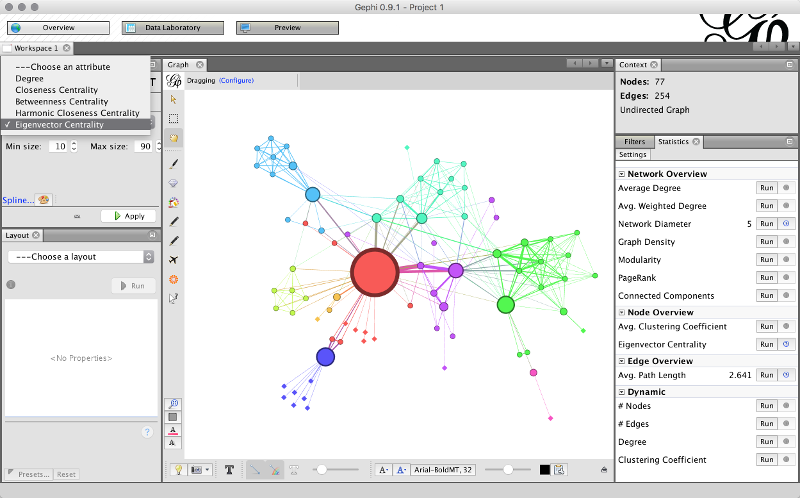<!-- .element width="800px;" --> <small>(Screenshot taken from [workshop material](https://jasonheppler.org/courses/csu-workshop/gephi.html) by Jason Heppler, 2016. Licensed under CC BY-NC-SA 4.0.)</small> -- ### Franco Moretti’s Analysis of „Hamlet“ (2011) 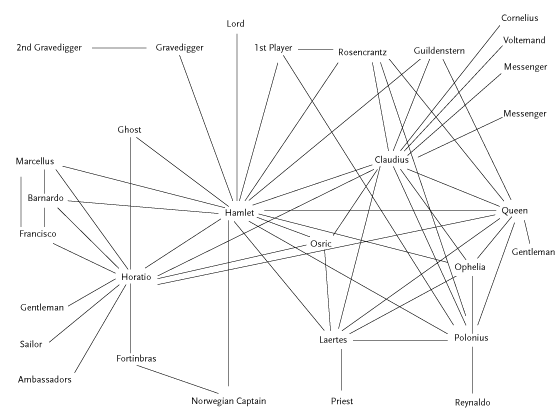<!-- .element width="640px;" --> <small>(Source: [newleftreview.org](https://newleftreview.org/II/68/franco-moretti-network-theory-plot-analysis).)</small> -- ## Distant-Reading Showcase (2016) 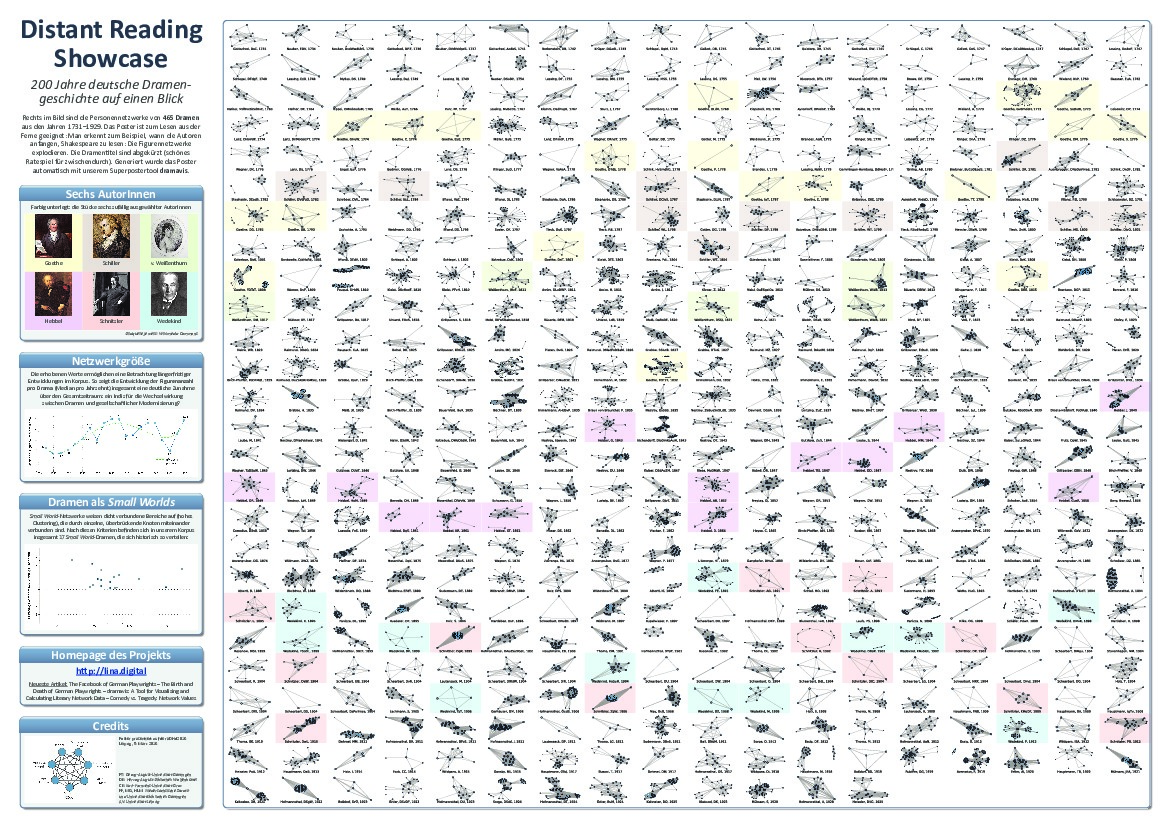<!-- .element width="680px;" --> <small>*Distant-Reading Showcase* (released at DHd2016, Leipzig).<br />Download via Figshare. DOI: [10.6084/m9.figshare.3101203.v2](https://dx.doi.org/10.6084/m9.figshare.3101203.v2).</small> -- ### Extraction of Literary Network Data: <br />A „Digital Spectator“ <br /> - following an idea of Solomon Marcus, „Poetica matematică“, 1970 - operationalisation of ‘interaction’: <br />„Two characters interact with one another if they perform a speech act within the same segment of a drama (usually a ‘scene’).“ --- ## Chapter 2. <br /> ## Programmable Corpora: <br />Networks for Literary Studies -- ## **DraCor** <br /> - DraCor: Drama Corpora Platform (https://dracor.org/) - DraCor is a showcase for the concept of „Programmable Corpora“ - Programmable Corpora: collection of full-text literary corpora with an API and Linked Open Data -- ## Frontend dracor.org 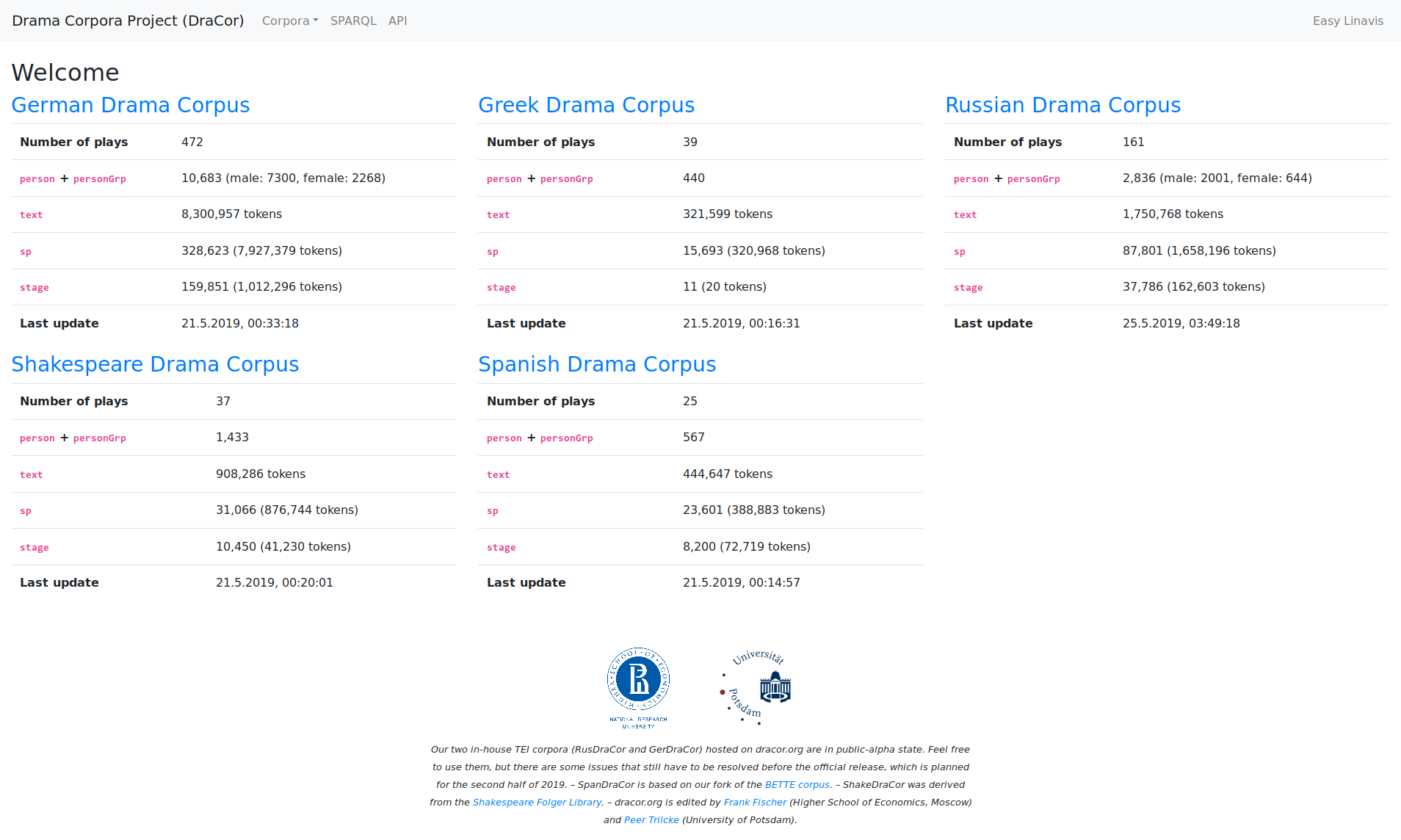<!-- .element width="840px;" --> <small>https://dracor.org/ (public beta!)</small> -- ## Connected Corpora <br /> - German, Russian, Spanish, Swedish, Italian, Shakespeare, Ancient Greek, Roman, … - full texts encoded in TEI (XML standard format in the Humanities, ~ 550 elements for the encoding of documents) - example: [Shakespeare’s „Hamlet“](https://dracor.org/shake/hamlet) -- ## DraCor Technology Stack  <small>All repos are open source: https://github.com/dracor-org</small> -- ## DraCor API <br /> - provides metadata and network data for all plays in CSV or GEXF format - character constellations per segment (*dynamic graphs!*) - spoken text (all characters, only female/male, or per character) - live documentation via Swagger: https://dracor.org/documentation/api/ -- ### Pushkin’s „Boris Godunov“ (1/2) 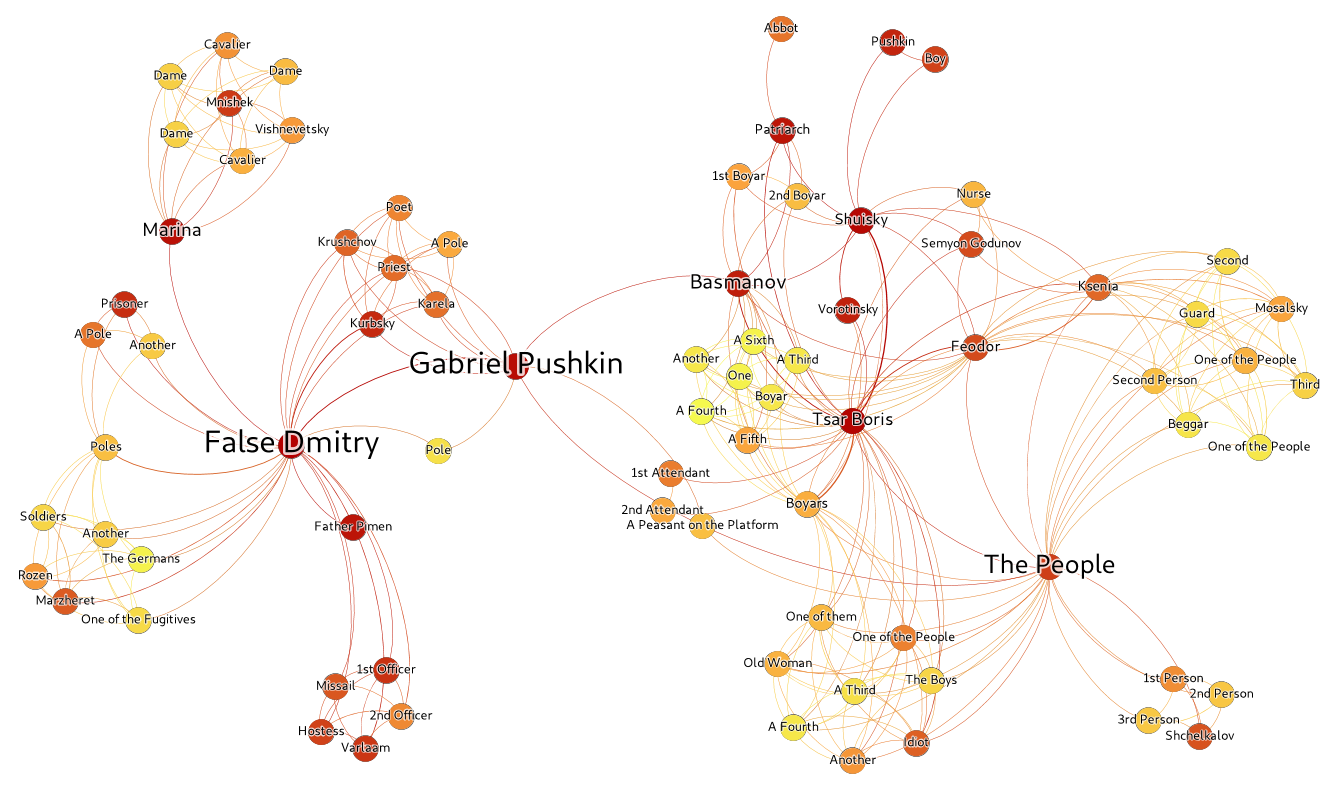<!-- .element width="720px;" --> <small>Correlations: Label size = betweenness centrality; heat of nodes = word-based measures.<br /><br />(Data source: GEXF file from https://dracor.org/rus/pushkin-boris-godunov.)</small> -- ### Pushkin’s „Boris Godunov“ (2/2) 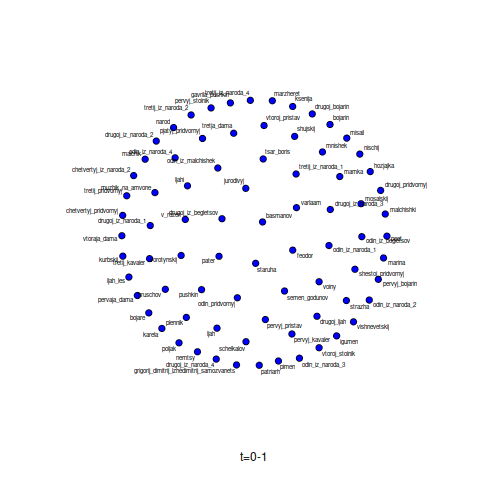 <small>**Dynamic graph**, generated with [**ndtv**](https://cran.r-project.org/web/packages/ndtv/index.html) package. Data coms directly from the **DraCor API**. <br />Script by Ivan Pozdniakov ([source code on RPubs.com](https://rpubs.com/Pozdniakov/godunov)).</small> -- ## DraCor Shiny App 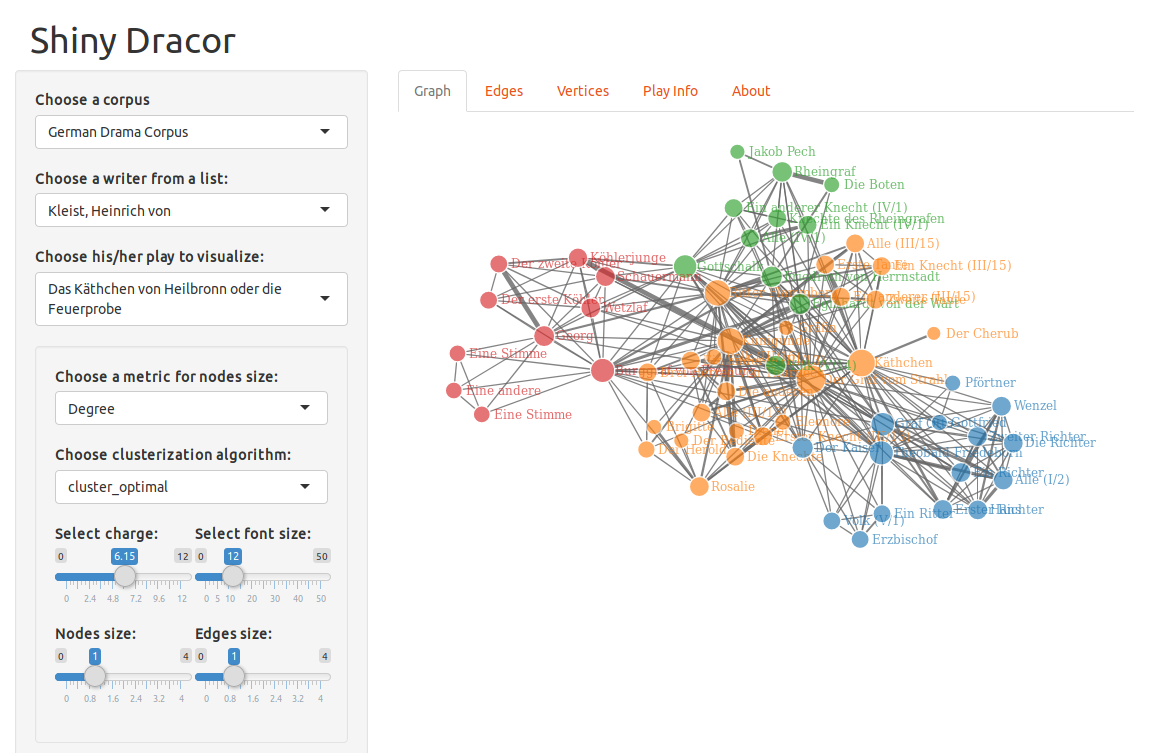<!-- .element height="480px;" --> <small>https://shiny.dracor.org/ (by Ivan Pozdniakov, based entirely on DraCor API).</small> -- ## Small-World Phenomenon in Russian Drama <!-- .element height="490px;" --> <small>Testing all plays against the criteria in Watts/Strogatz 1998. <br />Repo: https://github.com/pixelmagenta/rusdracor-small-worlds.</small> -- ## Gamification: „Brecht Beats Shakespeare!“ 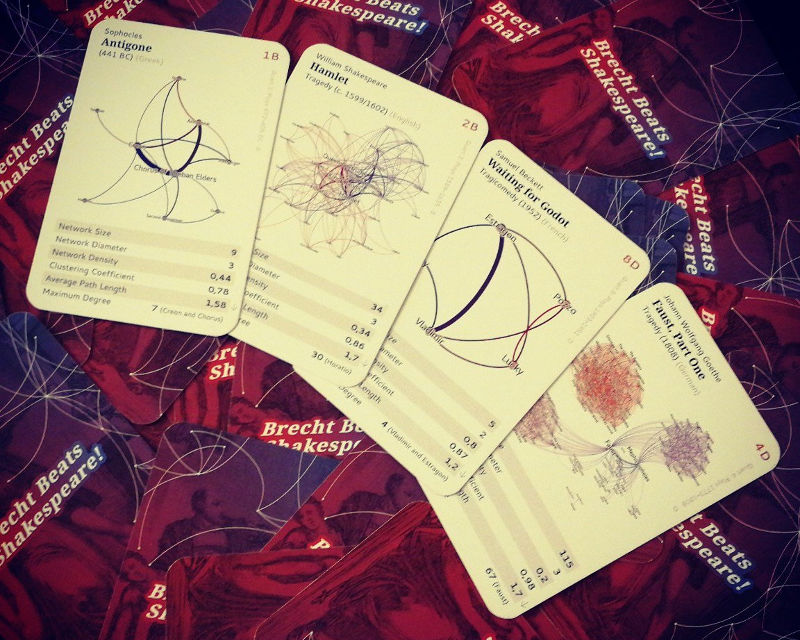<!-- .element width="600px;" --> <small>„Brecht Beats Shakespeare!“ (released at DH2018, México).<br />Download via Figshare. DOI: [10.6084/m9.figshare.5926363.v1](https://doi.org/10.6084/m9.figshare.6667424.v1).</small> --- ## Chapter 3. <br /> ## Catching Protagonists: <br />Quantitative Dominance Relations -- ## What Are „Quantitative Dominance Relations“? <br /> - term coined by Manfred Pfister (1977) - modelled by us as multi-dimensional vector of network- and word-based features -- ## Calculation of Rankings for 8 Measures <br />(For Every Character in Every Play) **5 network-based**:<!-- .element: style="font-size:0.9em;" --> - <!-- .element: style="font-size:0.9em;" -->Degree - <!-- .element: style="font-size:0.9em;" -->Weighted degree - <!-- .element: style="font-size:0.9em;" -->Closeness centrality - <!-- .element: style="font-size:0.9em;" -->Betweenness centrality - <!-- .element: style="font-size:0.9em;" -->Eigenvector centrality **3 word-based**:<!-- .element: style="font-size:0.9em;" --> - <!-- .element: style="font-size:0.9em;" -->Number of words - <!-- .element: style="font-size:0.9em;" -->Number of speech acts - <!-- .element: style="font-size:0.9em;" -->Number of appearances -- ## Example: Character Rankings for „Hamlet“ (Excerpt) <br /> |Character |Words|Speech <br />Acts|Appea-<br />rances|Between-<br />ness|Close-<br />ness|Weighted <br/>Degree|Degree|Eigenvector|TEXT <br />(total)|NETWORK <br />(total)| |----------|-----|-----------------|------------------|------------------|----------------|--------------------|------|-----------|------------------|---------------------| |Horatio |4 |4 |4 |1 |1 |4 |1 |3 |4 |1 | |Gertrude |7 |6 |3 |3 |2 |3 |2 |1 |5 |2 | |Claudius |2 |2 |2 |4 |3 |2 |3 |2 |2 |3 | |Hamlet |**1**|1 |1 |2 |4 |1 |**4** |4 |1 |4 | |Laertes |5 |5 |7 |5 |5 |6 |5 |6 |6 |5 | |Polonius |3 |3 |5 |6 |6 |5 |6 |5 |3 |6 | |Ophelia |6 |7 |8 |7 |7 |9 |7 |7 |7 |7 | |… |… |… |… |… |… |… |… |… |… |… | <br /> <small>Top-7 characters of the play regarding their degree values (out of 38 characters in total).<br /><br />Hamlet ranks 1st for the number of words, but only 4th for degree (too many monologues? 🤔).</small> -- ## Correlation of Word- & Network-Based Rankings <!-- .element width="480px;" --> <small>Distribution of **Spearman’s rank correlation coefficient** for <br />word- vs. network-based measures in Russian Drama Corpus.</small> -- ## Ranking Results <br /> - for > 50% of plays, a definite *quantitative* main character is identified, ranking first in at least 7 of the 8 measures (in Russian and German Drama Corpus) - yet literary texts can have more than one definite protagonist -- ## Major and Minor Characters <br /> - division into **four groups** (following „Reallexikon der deutschen Literaturwissenschaft“, 2003): - I. main characters - II. secondary characters - III. marginal characters - IV. functional characters - using ```cut``` function (in R) -- ## Groups of Importance <!-- .element width="720px;" --> <small>Shares for each group of characters in the entire Russian Drama Corpus.</small> -- ## The „Chekhov Effect“  <small>Percentages of first-group characters divided <br />by **degree** in the entire corpus **by decade**.</small> --- Thanks. <br /><br /> https://dracor.org/ <br /><br /> #ProgrammableCorpora